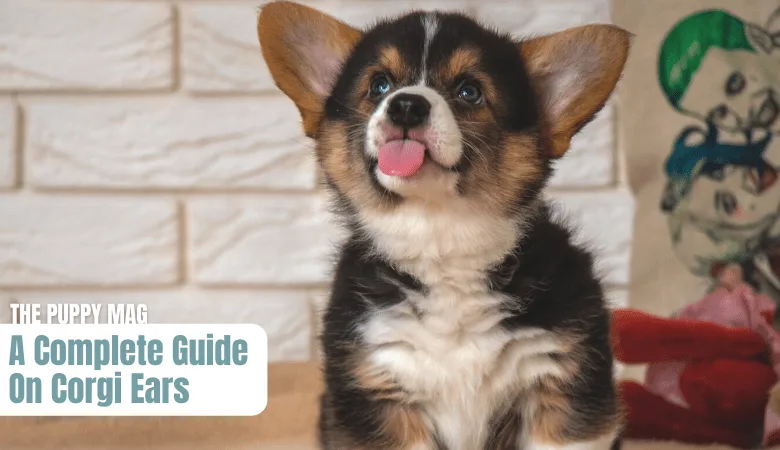Wonder when those cute little ears will stand up? Yep, you’re with every other corgi puppy owner!
Owners have all kinds of questions about corgi ears and in this article, we explain absolutely everything you need to know.
Corgi ears usually begin to stand up from as early as 8 weeks old, but for others, it could take months to see movement. Corgis typically have standing ears by 6-7 months old.

Table of Contents
When Do Corgi Ears Stand Up?
Ears usually start to stand up from 8 weeks old, but it isn’t a smooth journey to the top. Ears typically stand up completely by 6-7 months.
This also coincides with when teething stops.
And what’s more, is that it’s not always a smooth journey for two standing ears… It’s very common to see your corgi’s ears dancing around, switching positions, with one up and one down for quite some time.
This is because all the while teething is happening, ear placement is heavily affected. Teething places a lot of stress on the jaw and neck muscles, which are directly linked to the supporting bones and cartilage in your corgi’s ears.
What Are Corgi Ears Supposed To Look Like?
As many owners worry about whether standing or floppy ears are “normal” or “correct”.
Let’s explain what corgi ears are supposed to look like, according to the breed standard.
Cardigan Corgi Ears
Traditionally, Cardigan Corgis have large, strong ears that are standing erect. They are moderately wide at the base while remaining proportional to the rest of their body. The ears are slightly rounded at the top and should not come to a sharp point. The AKC points out that small or pointed ears are considered faults.
Pembroke Corgis Ears
Pembroke Corgis have similar ears to the Cardigan, although there are a few differences. Pembrokes typically have slightly smaller ears and should be of medium size, standing erect and tapering slightly to a rounded point.
The AKC points out that bat eats, cat-like ears, overly large weak ears, ears carried too high or low are “undesirable”. Button rose or drop ears are considered serious faults.
Important note: To clarify, the AKC uses the term “fault” in regards to whether or not the Corgi could compete in shows. Having a “fault” does not mean the Corgi has negatively affected health or hearing, nor does it confirm whether they are purebred or crossbred.
One way to confirm breed standard ears: The AKC notes that if you were to imagine a straight line from the nose tip, passing through both eyes to the ear tips and then across, it should form an approximate equilateral triangle.

Can Corgis Have Floppy Ears?
For some corgis, permanent floppy ears are a reality, but it’s admittedly quite rare and the majority of corgis will go on to have raised ears, even if they take quite some time to rise up.
Many owners ask if a corgi with floppy ears is purebred. This is understandable considering how rare floppy ears are, so does it suggest crossbreeding?
The truth is that even some purebred corgis can have floppy ears, and while mixed genetics could be the answer, it isn’t always.
⭐ Most likely reasons for floppy ears in corgis:
- Ears too large for the bones and cartilage to support them
- Early-on ear damage (from too much fondling or touching)
- Mixed genetics
- They are still teething! (some corgis have floppy ears for months before they start to rise up)
An important takeaway from this section is about handling your corgi’s ears too much. Although these giant velvet ears are tantalizing to touch, it’s crucial to leave them alone.
The more you fondle with your corgi’s ears, the higher the chances of damaging their fragile bones or cartilage (and therefore floppy ears too!).
What If Your Corgi Has Floppy Ears After 8 Weeks?
Firstly, many corgis take a lot longer than 8 weeks to see their ears rise up, so this could just be the case for yours too.
However, if you want to remain on the safe side, you can visit your veterinarian to ensure the ears are healthy and rule out potential issues.
After this, assuming good health, your veterinarian may offer help with taping (covered below) or you can just leave the ears.
There’s nothing wrong with floppy ears, and there’s still a chance the ears will raise on their own towards the end of teething… Many veterinarians will recommend waiting over taping.
Trending article: Shaved Corgis: All Your Questions Answered
Cardigan & Pembroke Ear Photo Examples
The following photos show three examples of Cardigan & Pembroke Corgis that have breed-standard ears.
As you can see, all of the ears vary slightly but are all examples of “correct” ear sets. Any other ear sets, either smaller, larger, floppy, bat/cat-like, or crooked, would be considered faults.
P.S Aren’t they so cute!


The following graphics were made using stock photos under our Canva Pro (premium license).
Should You Tape Your Corgi’s Ears?
It’s becoming increasingly common for owners to use tape to ensure their corgi’s ears grow and remain in an upright standing position.
For those that have never heard of this, it might sound a tad extreme, but it is a recognized thing that even veterinarians recommend and help with.
Will taping your corgi’s ears hurt them or cause pain?
As long as the ears are taped in the correct position, then taping them upright will not cause pain or hurt them. Granted, it may be a little uncomfortable, but not painful.
Do you need to tape your corgi’s ears?
Taping is just an option for those that absolutely want to guarantee upright standing ears.
Taping is not a requirement and leaving your corgi’s ears floppy (if they are floppy) will not contribute to bad hearing or negative health.
When is the best time to tape your corgi’s ears?
It’s best to let the ears try to rise on their own, but if by 5-6 months the ears are still down, you can consult with your veterinarian about taping them upright. Some vets will still suggest waiting (due to teething) but taping from this age is best to ensure strong upright ears.
Can you tape your corgi’s ears at home?
Taping your corgi’s ears is not as simple as slapping on some masking tape. It’s crucial to receive help from a professional to do this. The ears MUST be taped up correctly. Any small misalignment could lead to the ears growing incorrectly resulting in permanent damage and future problems.
How long do corgis need their ears taped?
Usually, the tape remains on the ears anywhere from a few weeks to a couple of months, every case is different. This ultimately depends on their overall development, age, and at what moment their ears were first taped. Always receive guidance from your veterinarian throughout taping.
Always consult a veterinarian if you are interested in taping your corgi’s ears.
The topic of taping is forever debated, and there are many strong opinions flying around. Personally, I won’t be taping my dog’s ears, even if they are “supposed” to be upright (as long as no health issues are to follow with floppy ears).
Many owners agree, and many don’t, and that’s okay. After all, taping does not cause any pain or hurt the dog as long as it’s done correctly. If you want to consider taping, that’s absolutely fine, just ensure to have your corgi assessed by a veterinarian first.
4 Tips For Healthy Ears
Let’s run through 4 tips for healthy corgi ears.
1. Encourage chewing & have plenty of chew toys
Having plenty of chew toys of various textures is crucial not just to help your corgi with teething pains, but to develop their jaw and neck muscles.
This will ultimately lead to stronger, firmer ears. The increased chewing may momentarily cause a lot of ear movement, but in the end, will equal stronger ears.
Pro Tip: Put a tablespoon of dog-friendly peanut butter inside a puppy KONG toy, and freeze it for 1-2 hours. The ice-cold temperature will provide instant pain relief for your teething pup, and the PB will keep them chewing in peace for 45 minutes straight.
In addition to a KONG, frozen rope toys are great, as well as frozen peeled bananas.
2. Avoid touching the ears
Despite how soft and amazing those ears are, it pays to avoid touching them while your puppy is very young. The more you fondle, fold, and stroke the ears, the higher the chances are of causing some damage.
I know, it sounds excessive, but those tiny ears have even tinier cartilages and bones that are still very fragile. If upright ears are important to you, avoid fondling.
3. Food and nutrition
The quality of your pup’s food is crucial for his or her overall growth and development, which certainly includes their ears!
Ensure your corgi is on a puppy-specific formula from a trusted brand that prioritizes “fresh” and “whole” ingredients. A high protein diet is important to support proper growth, and it’s always best to avoid high-carb kibbles.
Aside from having a high-quality diet on paper, it’s vital your corgi is actually getting on well with it. Some high-quality options don’t sit right with every dog out there, so be sure that your corgi is digesting the food well.
4. Plenty of rest & recovery
One of the reasons corgi puppies sleep so much is because growing takes up a lot of energy. This is why it’s crucial to allow your puppy as many naps and sleeps as they desire. After all, this is when the majority of their growth happens.
Ensuring plenty of rest and recovery will give your pup the best chance of growing big strong healthy ears.
While this is easy for us adults to grasp, it’s important to inform our children to do the same. And then remind them a few more times! lol.
Last Thoughts
Corgis typically have large, strong ears that stand upright. In rare cases, some corgis will have floppy ears, small ears, overly large ears, bat-like ears, or cat-like ears.
Pembroke corgis typically have slightly smaller ears than Cardigan corgis, but the overall shape is generally the same.
Corgi ears should taper off into a rounded point, with pointy ears being considered a fault (according to the breed standard).
As corgis ears are usually fairly large, it can take some time before they rise up. Some corgi owners might see their corgi’s ears rise up as early as 8 weeks old, whereas, for others, it will take considerably longer (around 4-6 months).
Ear placement is notoriously hard to predict in the early stages. This is because teething causes extreme stress on the jaw and neck muscles, which are directly linked to the bones and cartilage in the ear.
This makes it common to see the ears dancing around up and down, in conjunction with waves of teething activity.
Some owners who want to guarantee upright “traditional” ears may opt to tape their corgi’s ears in an upright position. This should always be done by a professional to ensure the tape and ear position is set correctly.
Taping is a heavily debated topic, and many people have strong opposing opinions on the matter. Although taping does not cause pain, it could cause discomfort, and if done incorrectly, cause further damage.
In most countries, it is still an option that veterinarians recommend and help with. If you are considering taping your corgi’s ears, that’s okay, just have a veterinarian assess and help with the process.
⭐ Thank you for reading! Back to more Corgi articles >>>
Resources:
AKC Cardigan Breed Standard
AKC Pembroke Breed Standard
PetMd Ear Taping
